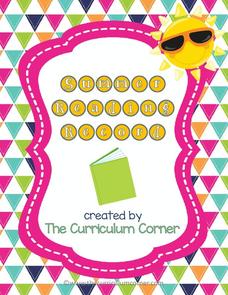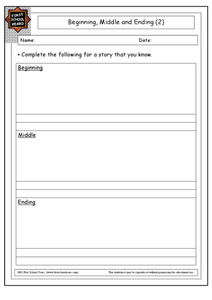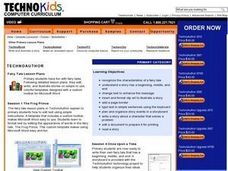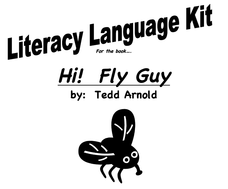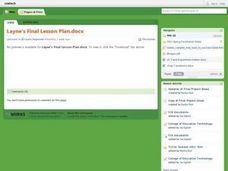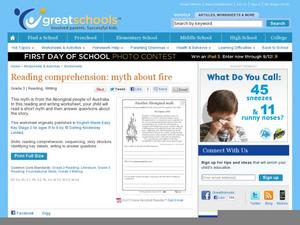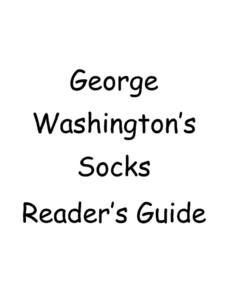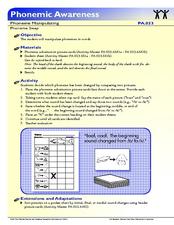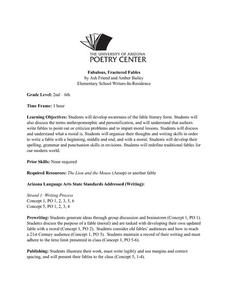Student Handouts
Beginning-Middle-End Chart
Track the plot of a book with a straightforward chart. Pupils write in the title of the book and then note down what happened at the beginning, middle, and end of the story.
Curated OER
Beginning, Middle, Ending of Story
In this retelling a story in order worksheet, students write short answers for the beginning, middle and end of a story of their choice. Students compete three parts of the worksheet.
Curriculum Corner
Summer Reading Record
No more summer reading lag! Give young readers a set of graphic organizers and worksheets to keep track of the books they read over the summer and to keep reading comprehension skills fresh. The graphic organizers include identifying...
Curated OER
Beginning, Middle, Ending (2)
In this story structure worksheet, students use a story map and write down the beginning, middle, and ending of a story they know.
Curated OER
Techno Author
Here is a great way to explore language arts by completing a computer activity with classmates. Youngsters read a fairy tale in class and analyze where the beginning, middle and end are. They create their own story using clip art and...
Curated OER
Build Mastery: Sequencing
Writing a summary is much easier once you've laid out the sequence of events. Show readers how these two skills are intertwined using this graphic organizer. Review the meaning of sequencing first, presenting the chart and possibly...
Scholastic
Transitional Guided Reading
Use a fill-in-the-blank lesson plan template to enhance your guided reading lesson plans with details surrounding decoding strategies, fluency and phrasing, vocabulary strategies, comprehension, and more!
Poston Butte High School
Literacy Language Kit for the Book Hi! Fly Guy
Create a buzz in your class with this collection of learning activities for the book Hi! Fly Guy. Including a list of comprehension questions, a sequence of events activity, a summary writing assignment, and a vocabulary list, this...
Curated OER
Where Do We Begin?
Primary learners grasp sequence of events by discussing morning routines and reviewing the story of Little Red Riding Hood. They explore the necessity of correct order of events. As a class, create a story with a beginning, middle, and...
Curated OER
Sequencing in Reading
Third graders explore language arts by analyzing a children's story in class. In this story structure instructional activity, 3rd graders read the book The True Story of the Three Little Pigs and write a brief summary. Students identify...
Curated OER
Fairy Tales
Once upon a time are four words most children are familiar with when reading a fairy tale. But do they know that fairy tales are a great way to learn the literary elements of reading and writing? Use a thorough fairy tale unit...
Curated OER
Reading Comprehension: Myth About Fire
No matter what you read, you can always practice locating the main idea and key details to increase reading comprehension. Third graders read about an Aboriginal myth, they then complete three short-answer questions using key details...
PB Works
George Washington’s Socks Reader’s Guide
Dive into a class reading of the book George Washington's Socks with the help of this guide. Including a vocabulary list and series of comprehension questions for each chapter, this resource provides an excellent foundation for...
Curriculum Corner
Summary Writing
Nineteen stylish worksheets offer lesson ideas and practice opportunities designed to reinforce summary skills. Scholars recall events over the weekend as well as favorite books—main characters, problems, solutions, the beginning,...
Florida Center for Reading Research
Phonological Awareness: Phoneme Manipulating, Phoneme Swap
Reading readiness can be a fun skill to foster. Scholars manipulate phonemes to change one word into another. They pick picture cards, say the object's name on the card, then change the final phoneme to create a new word. They then find...
Curated OER
Beginning, Middle, or End?
Here's a instructional activity to help students become familiar with where to find words in a dictionary. Students whether the each of the 15 flower related words would be found at the beginning, middle or end of the dictionary.
PB Works
George Washington’s Socks: Short-Answer Questions Chapters 1-9
Build a literature unit around the book George Washington's Socks with this series of short answer questions. Broken up in two- and three-chapter increments, these reading comprehension questions allow young readers to demonstrate...
K12 Reader
Narrative or Expository?
Narrative or expository? That is the question readers face on a two-part comprehension activity that asks kids to read a short passage about these two different types of writing, and then to answer a series of comprehension questions...
Curated OER
Writing: Mentor Text Lesson & Microteaching
Mentor texts are a great way to demonstrate how to write with purpose. Pupils will be reintroduced to two well-known books and then asked to think about them from the writer's point of view. They will see that the author had to use basic...
Curated OER
Using Children's Literature to Teach Writing: No, David!
Students review beginning, middle, and end of a story and how details add to a story.
Curated OER
Monitoring Comprehension Progress: Story Retells
Pupils retell a story by filling out a record sheet. In this retelling lesson plan, students fill out a record sheet that gives them prompts about the beginning, middle, and end of a story.
Curated OER
Descriptive Writing Using the Book Rumpelstiltskin
Use the fairy tale Rumpelstiltskin to teach your third grade class about descriptive writing. Following a teacher read-aloud of the story, the class brainstorms a list of adjectives describing the main character. Students use this list...
Miami-Dade County Public Schools
Veteran's Day—Honoring All That Served
Looking for ideas on ways to recognize Veteran's Day? Check out this 92-page packet that includes exercises designed for all grade levels. Reading passages detail the history of the holiday, research projects get individuals involved in...
Curated OER
Fabulous, Fractured Fables
Elementary schoolers develop an awareness of the literary form known as the fable. They explore how authors write fables to pass along moral lessons. After reading and discussing many famous fables embedded in the plan, learners attempt...


